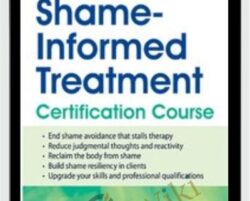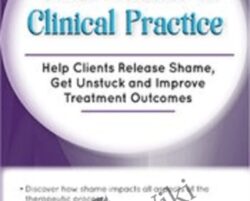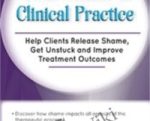Clinicians often report feeling “stuck” and unsure of the reasons why clinical strategies aren’t working. In this recording shame expert, Patti Ashley, Ph.D., LPC, will help enhance your clinical skills using neurobiological-informed and relational-informed strategies for identifying and treating toxic shame.Toxic shame is like an infectious disease that lies untreated due to symptoms being difficult to recognize or misdiagnosed. Learning how to recognize and treat toxic shame requires you to be vulnerable and courageous in the therapy session.Recognizing the signs of toxic shame in the assessment and treatment process can be difficult. Here are some examples of client behaviors to watch for that could indicate shame:Frequently cancels sessionsTerminates treatment earlyDeflects and projects onto othersNarcissistic self-inflationPerfectionismMinimizationAnger, rage and contemptand moreThis recording will take you back to the origins of shame and help you identify the non-verbal unspoken and unseen aspects in clinical work. Understanding how shame can undermine the therapeutic alliance and using somatic strategies to deepen an authentic relationship with the client are the keys to working with toxic shame in clinical practice.Dr. Ashley has heard other clinicians who have taken this workshop say they experienced a “sigh of relief.” This is a recording you don’t want to miss!Summarize the nature of toxic shame as it relates to the therapeutic process.Identify how the different attachment styles play a role in how client’s shame is formed.Discover how toxic shame develops as a core identity and how it can be a roadblock in clinical treatment.Correlate how toxic shame and trauma function similarly to the nervous system and how that relates to clinical treatment.Utilize clinical strategies to help heal shame and get clients unstuck in the therapeutic process.Develop skills to help clients regulate shame triggers both in-session and everyday living.Get Toxic Shame in Clinical Practice: Help Clients Release Shame, Get Unstuck and Improve Treatment Outcomes of author Patti Ashley only price 79$PART ONE: HOW SHAME SHOWS UP IN TREATMENTToxic ShameResearch & DefinitionsRuptures in interpersonal relationships create a shame-based identityShame and trauma function similarly in the nervous systemSubconscious shame effects of poisonous parentingAttachment theories as they relate to shameD.W. Winnicott’s true self/false selfShame in family, culture and other systemsLimitations of the researchSigns of Toxic Shame:What to Watch for in Assessment and BeyondIndividual Therapy – the client who:Talks the whole sessionFrequently cancels sessionsFeels bad when progress seems to have eludedTerminates treatment earlyDeflects and projects onto othersRelapses and does not returnMinimizes problemsExcessively intellectualizes and analyzes treatmentCouples/Family TherapyThe attack/defend patterAnger, rage and contemptJudgment of self and othersGrandiosity, narcissism and self-inflationPeople pleasing and codependencyAvoidanceProblems with intimacyGroup Therapy:Cross-talkIntellectualizingSilenceJudgmentConflictWhen the Therapist is Part of the ProblemRigid Treatment Models May Increase Shame and Decrease Positive OutcomesShame can be activated when therapist appears to be the “expert”Some strategies hinder treatment outcomesStrategies that may create barriers to creativity and relational presenceImpact of mirror neurons and epigeneticsHow naming “shame” can be shamingUnconsciously enacting shaming parentTreating client as appointment or diagnosisWhat to do when your shame is triggered in-sessionPART TWO: TREATING THE TOXIC SHAME Effectively Treat Toxic ShameImplications for Treatment to Move Forward with ClientsRight and left brain integrationBottom-up versus top-down treatment approachesModeling, engaging and sustaining self-compassionRepair the interpersonal bridge to self and othersCourage and vulnerability in right-brain regulationSustaining empathy in parallel processTransference and counter-transference in treatmentTherapeutic Strategies:Putting It All to PracticeBuild a Safe Therapeutic Holding EnvironmentEstablish safety and trustSet a stage for treatmentStrong foundation for therapeutic workBuild a Solid RelationshipTherapeutic empathy as the antidote for shameConnect and establish equal powerMindfulness and compassionBridge the Head and HeartPsycho-education to demystify shame”I” statements to identify shame-based feelingsGoing beyond cognitive therapy modelsWitness and guide clients through deeper layersReturn shame to its originSomatic strategiesRe-wiring new neural pathwaysExperiential Tools and TechniquesCreative arts, writing and movement activitiesMindfulness and meditationArchetypes, story-telling and mythologyMusic and sound healingJournaling and letter-writingWorking with SecretsPatience and compassionDeeper shameTolerance and non-judgmental witnessingCreativityEvery client is uniqueHow therapy is like artGoodness of fitResearch limitations and potential treatment risksGet Toxic Shame in Clinical Practice: Help Clients Release Shame, Get Unstuck and Improve Treatment Outcomes of author Patti Ashley only price 79$Tag: Toxic Shame in Clinical Practice: Help Clients Release Shame, Get Unstuck and Improve Treatment Outcomes – Patti Ashley Review. Toxic Shame in Clinical Practice: Help Clients Release Shame, Get Unstuck and Improve Treatment Outcomes – Patti Ashley download. Toxic Shame in Clinical Practice: Help Clients Release Shame, Get Unstuck and Improve Treatment Outcomes – Patti Ashley discount.
 2-Day Shame-Informed Treatment Certification Course – Patti Ashley
₹28,386.00
2-Day Shame-Informed Treatment Certification Course – Patti Ashley
₹28,386.00
 The Source Code to Business Success and Advanced Wealth Attraction
₹22,576.00
The Source Code to Business Success and Advanced Wealth Attraction
₹22,576.00
Toxic Shame in Clinical Practice: Help Clients Release Shame, Get Unstuck and Improve Treatment Outcomes – Patti Ashley
₹12,450.00





